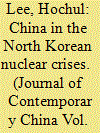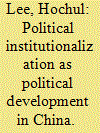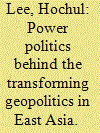|
|
|
Sort Order |
|
|
|
Items / Page
|
|
|
|
|
|
|
| Srl | Item |
| 1 |
ID:
123966


|
|
|
|
|
| Publication |
2013.
|
| Summary/Abstract |
China reacted very differently to the first and second North Korean nuclear crisis: engaging in passive and 'behind-the-scenes' diplomacy in the first and choosing more proactive and 'stage-managing' diplomacy in the second. This article has sought to explain this striking contrast in China's foreign behavior. Though most studies tend to rely on Chinese strategic and security interests in explaining China's proactive diplomacy as demonstrated in the six-party talks, those strategic and security interests do not explain directly the contrasting foreign behavior of China. China faced basically equal strategic and security concerns and equally dangerous potential military conflict between the US and North Korea through the first and the second nuclear crises. This article, then, argues that 'same interests, but different behaviors' should be explained not by China's external interest calculus but by internal changes within China itself. By the turn of the new millennium, China had undergone an evolutionary change of state identity from a cautious accommodator to an active constructor, or from a state of 'taoguang yanghui' to a state of 'fuzeren daguo'. The contrasting foreign behaviors in the first and second nuclear crises are profoundly reflective of this identity shift of China.
|
|
|
|
|
|
|
|
|
|
|
|
|
|
|
|
| 2 |
ID:
186802


|
|
|
|
|
| Summary/Abstract |
Beginning in the late 1970s in China, Deng Xiaoping shifted the Chinese Communist Party (CCP) line from revolution to reform, confining economic reform within the principles of socialism and communist party rule, with the political logic for party rule meant to prevail over the economic logic for economic development. However, as the reform proceeded, the CCP was led to concede to the economic logic. Even though the CCP set the building of a socialist market economy (SME) as the goal of economic reform, the actual reform path traversed not only marketization but also more importantly privatization. Throughout the shareholding reform of state-owned enterprises (SOEs), conversion of state-owned commercial banks (SOCBs) into stock companies, and the mixed ownership reform (MORs) of SOEs, the CCP had to accept the expansion of privatization for reasons of economic performance, despite the subsequent increase in ideological and political difficulties such would entail for regime identity and party rule, thus generating a political dilemma for the CCP.
|
|
|
|
|
|
|
|
|
|
|
|
|
|
|
|
| 3 |
ID:
095546


|
|
|
|
|
| Publication |
2010.
|
| Summary/Abstract |
Contrary to many doubts, the institutionalization of political leadership survived the succession process in China between 2002 and 2003. In 2004, Jiang Zemin attempted to override the institutionalized political leadership but was unsuccessful. These episodes demonstrate the level of political institutionalization that has been steadily undertaken since the reform and opening of China. After theoretically defining institutionalization as the first significant stage of political development, this article examines the current progress in political institutionalization at two distinct levels: external and internal. This article argues that the Chinese Communist Party (CCP) leadership intended to establish political stability directly and facilitate economic development indirectly under the goal of sustaining the political legitimacy of the CCP's rule of China. Finally, this article examines whether China would follow the ideal sequence of political development, i.e. institutionalization leading to participation leading to contestation. Though China has achieved considerable political institutionalization and conducted many experiments of expanding political participation, public contestation is still confined solely to within the party. Thus, it remains to be seen whether or not China will follow the ideal sequence.
|
|
|
|
|
|
|
|
|
|
|
|
|
|
|
|
| 4 |
ID:
158059


|
|
|
|
|
| Summary/Abstract |
Current geopolitical dynamics in East Asia is generated by the US rebalancing and China’s counterbalancing. The US rebalancing has so far ended in an encircling of China, whereas China counteracts to extend into the seas and the lands as typified by the Belt and Road Initiative and assertive activities in the South China Sea. China under Xi Jinping’s leadership has set up a new guideline of ‘great power foreign policy’ (大国外交) to realize Xi Jinping’s ambitious vision of ‘China dream’. As delivered in the ‘New Model of Great Power Relations’, China under Xi Jinping’s leadership seeks clearly for ‘regional dominance’, while for ‘global balance’ with the USA. With rebalancing, however, the USA seeks to restore power balance in East Asia by adding up to military and economic resources already deployed there. By doing so, the USA aims to achieve its strategic goal of ‘regional balance’, while maintaining ‘global dominance’. These two distinct strategic goals, regional dominance and global balance for China and regional balance and global dominance for the USA, interact to result in currently transforming geopolitics in East Asia.
|
|
|
|
|
|
|
|
|
|
|
|
|
|
|
|
|
|
|
|
|